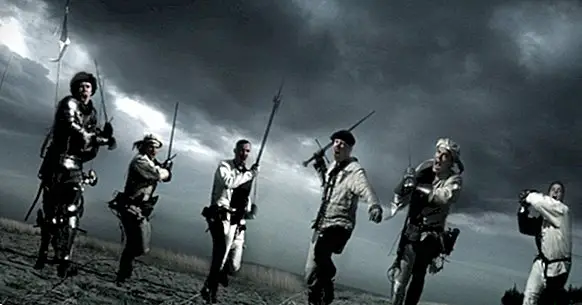The 11 types of conflicts (and how to solve them)
Conflicts are common in interpersonal relationships , because each person has their idea and vision of the world. This can cause differences that go beyond simple discrepancies.
Poor communication can be the source of conflict, so this is a necessary element in the mediation and proper management of the conflict. In this article we review the 11 types of conflicts and how to solve them .
Causes of conflicts
Efficient communication is a necessary tool to understand others and the problems that can lead to conflicts, because it allows us to understand differences in cultural and ideological values that may be at the root of the problem and, in addition, can prevent the conflict from leaving. of the hands.
The causes of conflicts may be different, since there are different types of conflicts . For example, there may be conflicts over economic interests between two companies, emotional conflicts in internal conflicts in a person, political conflicts between two countries, religious conflicts between two communities or conflicts of competence between two police forces.
Although conflict is seen as a bad thing, sometimes it can be an opportunity to improve things that do not go well or do not work.
Types of conflicts
As you see, the causes of conflicts can vary: values and ideologies, resources, expectations within the relationships between people, clash of personalities, the protection of the territory, etc. These causes are usually more common in different types of conflicts. But, How are conflicts classified? What types of conflicts are there?
Conflicts may vary according to their content, their veracity or according to the participants. Below you can find the different types of conflicts and their characteristics.
1. Conflicts according to their veracity
According to their veracity, conflicts can be:
1.1. Real conflicts
The real conflicts are those that actually exist, and that are caused by various causes , whether structural or environmental (economic, legal, relational, etc.), among others.
- For example : Pablo rents his house to Adrián with a monthly cost of 600 euros, because the latter has moved to the big city. Everything goes well until Adrian loses his job and, as a result, stops paying the rent. It creates an economic conflict that is real.
1.2. Imaginary conflicts
Imaginary conflicts derive from misunderstandings, interpretations or perceptions . In this type of conflict there is no will on the part of the parties.
- For example : María thinks that Juan, her partner, no longer feels the same for her. Juan has run out of battery and has not been able to call him as he does every night. Actually, Juan is worried about not being able to call him, but he does not have the possibility to do it at that moment. There is no conflict, but Maria thinks that the reason why Juan does not call him is because he is with another woman.
1.3. Invented conflicts
Invented conflicts, as with imaginary conflicts, are not real . However, unlike these, there is an intention on the part of some of the parties that, generally, want to get some benefit. This makes that much of this phenomenon is actually manipulation or gaslighting.
- For example : a person who simulates an accident so that the insurance will pay for the repair of a back blow that happened because he himself hit a lighting pole when he backed off.
2. Conflicts according to the participants
According to the actors involved in the conflict, this can be:
2.1. Intrapersonal conflict
This conflict occurs internally, in the mind of the individual . This means that it has its origin in private events: thoughts, values, principles, emotions ... These conflicts can have different degrees.
- For example: from a daily conflict about what to eat today, to an existential crisis that causes great suffering to the person who suffers it. Intrapersonal conflicts can help us grow as people if we resolve them satisfactorily.
- Related article: "Existential crisis: when we do not find meaning in our life"
2.2. Interpersonal conflict
Interpersonal conflicts are those that occur in the processes of interaction between people . They usually appear quickly, since it is only necessary for a single person to feel attacked in order to initiate one, which causes them to be born as a result of misunderstandings. They can be originated by practically any motive, from jealousy to conflict of interests in relation to the use of a type of resource.
- For example : between two friends. The origin can be found in a clash of personalities, values, opinions or expectations.
2.3. Intragroup conflict
Intergroup conflicts occur between members of a group or team , for several reasons: due to interpersonal differences or because some of the participants of the group do not share the ideas of the organization, among others. This type of conflicts can destabilize the good progress of a team or group and affect their effectiveness and cohesion, since they create an extra concern or even block the group's ability to operate, which in turn can lead to more conflicts in a chain reaction.
2.4. Intergroup conflict
Intergroup conflict is a conflict between groups and can be very destructive, because, in extreme cases, The violence derived from this type of conflict is aimed at group reinforcement and can even be justified . It usually has its causes in ideologies, prejudices or territorial disputes.
On the other hand, unlike what happens in interpersonal conflicts, it is more difficult that they arise from misunderstandings, since the presence of other people makes the "contagion effect" necessary to be considered a intragroup conflict delays the appearance of this. In addition, a greater number of observers makes it less likely that misunderstandings may occur that remain over time.
- For example : the conflict between two companies for economic reasons, a war between peoples for their religion or between "hooligans" for their football team.
- If you want to know more about the negative impact of intergroup conflicts, you can read our article: "Hooligans: The Psychology of Football Thugs"
3. According to the content
Depending on the content, the conflict may be:
3.1. Relational conflicts
These conflicts occur between members of a family, friends or partner .
- For example : because of the bad communication between the two members of a marriage, one ends up arguing about any everyday trifle.
3.2. Conflicts of interest
Conflicts of interest have to do with motivations and the needs of each person or group and with the resources present at that moment.
- For example: when a worker wants more money for the workday and the company does not want to pay more.
3.3. Ethical and values conflicts
They have to do with the culture and environment in which the person has grown . They are frequent and complex, because it is not easy for a person to change the principles that govern their behavior. In the case of ethical conflict, it usually occurs when a person has to make a decision that does not agree with their deepest values.
3.4. Conflicts of leadership and power
Leadership conflicts mainly affect organizations and can affect performance and the health of the workers. A characteristic phenomenon of conflicts has to do with the power struggle, since many authors speak of the relationship between conflict and power, being one of the most common causes.
3.5. Conflicts of personality
Personality is a set of stable traits and qualities that shape a person's way of being and makes us unique. The personality, being a little flexible phenomenon, can be the basis of many intergroup conflicts .
How to resolve conflicts
Conflicts, in many cases, can bring about positive changes . For this it is necessary that they be managed correctly. It is important to understand that making a correct diagnosis of the conflict will determine the success in solving the different problems. If we approach an intergroup or interindividual conflict as if it were an intraindividual conflict, the chances of success may be scarce.
For example, we may find ourselves working in a company in which the main problem is the bad practices of the human resources department, which is generating a role conflict in the workers. They do not know exactly what their functions are, and this conflict generates stress and discomfort in the employees. If we approach this situation as a worker's problem, we will be attacking the wrong goal.
Maybe we can reduce the symptoms momentarily, but the problem will still be there, in the bad organizational management. Therefore, before taking any action to mitigate the effects of the conflict, it is necessary to know what is the root or the basis of the problem.
However, There are some principles that we must apply if we want to resolve the conflict :
- Do not pretend that the problem does not exist. Face it and try to solve it.
- Be critical and analyze your failures.
- Treat the other party with respect and education.
- Explain your opinions and establish the points of union.
- Be empathic with the other party and understand their position.
- Avoid confrontation.
- Improves communication: active listening, assertiveness ...
If you want to know how to improve your negotiation skills, this post may interest you: "How to be a great negotiator, in 10 psychological keys".
Bibliographic references:
- Calcaterra, Rubén A. (2002). Strategic mediation Barcelona: Gedisa. ISBN 978-84-7432-901-8.
- Dahrendorf, Ralf. (nineteen ninety six). Elements for a theory of social conflict.In: Society and freedom: towards a sociological analysis of current affairs. Madrid: Tecnos.
- Entelman, Remo F. (2002). Theory of conflicts: towards a new paradigm. Barcelona: Gedisa. ISBN 84-7432-944-2.
- Vinyamata Camp, Eduard. (2003). Learn mediation Barcelona: Paidós Ibérica. ISBN 978-84-493-1364-6.



















